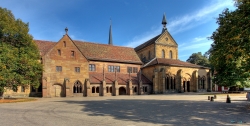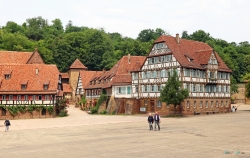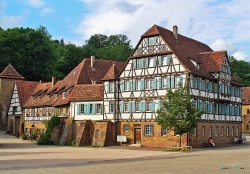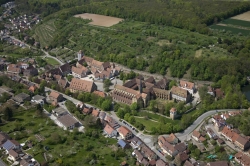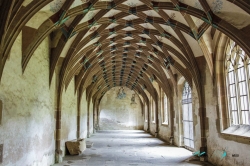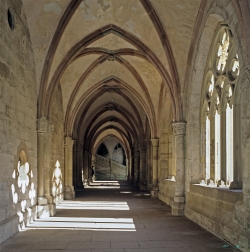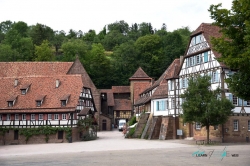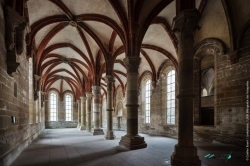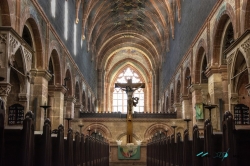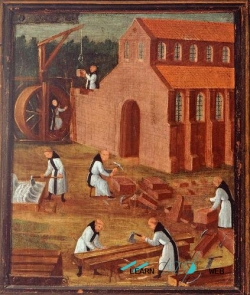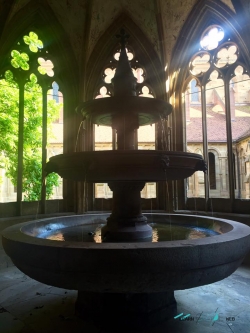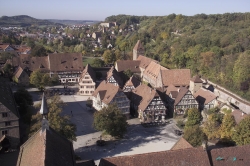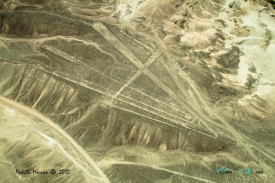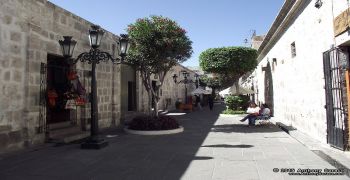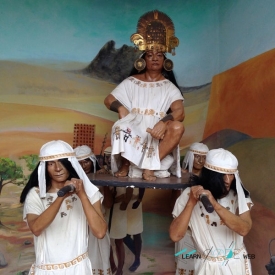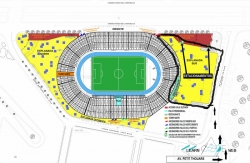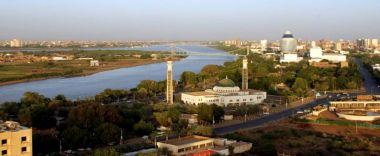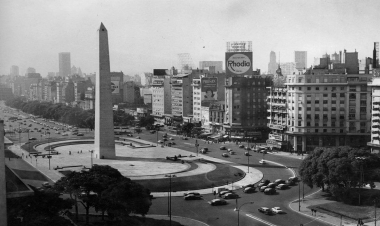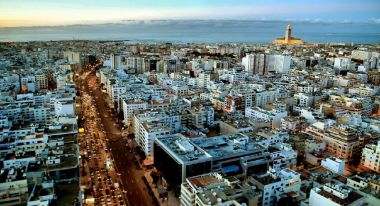ABOUT Maulbronn Monastery
Maulbronn Monastery (German: Kloster Maulbronn) is a former Cistercian abbey and ecclesiastical state as an imperial abbey in the Holy Roman Empire located at Maulbronn, Baden-Württemberg. The monastery complex, one of the best-preserved in Europe, was named a UNESCO World Heritage Site in 1993.
The monastery was founded in 1147 by a group of Cistercian monks who had been moved from an abandoned project 8 km (5.0 mi) away in present-day Mühlacker. Maulbronn experienced rapid economic and political growth in the 12th century, but then hardship in the late 13th century and the 14th century. Prosperity returned in the 15th century and lasted until Maulbronn was annexed by the Duchy of Württemberg in 1504. Over the 16th century, the Cistercian monastery was dissolved and replaced with a Protestant seminary. It also became the seat of an important administrative district of the Duchy and later Kingdom of Württemberg.
The complex, surrounded by turreted walls and a tower gate, today houses the Maulbronn town hall and other administrative offices, a police station, and several restaurants. The monastery itself contains an Evangelical seminary in the Württemberger tradition and a boarding school.
In 1138, a free knight named Walter von Lomersheim donated an estate at Eckenweiher (now Mühlacker) to the Cistercian Order for the establishment of a new monastery. The donation was received by Neubourg Abbey, which dispatched twelve choir monks and an unspecified number of lay brothers. They arrived in 1138, but found Eckenweiher to be lacking in water and pasture space in sufficient quality and quantity, and subsequently abandoned the site a few years later. In 1147, the Eckenweiher monks were moved to a new site near the source of the Salzach river by the Bishop of Speyer, Günther von Henneberg [de]. This site, Mulenbrunnen, was about 8 kilometers (5.0 mi) from Eckenweiher, was ideal for the Cistercians. Maulbronn, in the hilly Stromberg region, was rich in water[a] and isolated, though it was also near the Roman road running from Speyer to Cannstatt. Construction of the Maulbronn Monastery complex began soon thereafter and was largely completed by 1200–01; the abbey church was consecrated in 1178 by Arnold I, Archbishop of Trier.
The new abbey at Maulbronn soon began a period of steady growth thanks to its favorable location and the backing of both Bishop Henneberg, a supporter of the Cistericans, and the Hohenstaufen, at the time the rulers of the Holy Roman Empire. Bishop Henneberg waived Maulbronn's obligation to pay levies for the large amount of forest its monks had to clear in 1148. That same year, Pope Eugene III granted the Maulbronn chapter the right of patronage. This began a period of economic expansion for the monastery, which aggressively pursued the acquisition of new territory, starting with the nearby Füllmenbacher [de] and Elfinger Hofs in 1152 and 1153 respectively. In 1156, Emperor Frederick I issued a decree that exempted Maulbronn from paying tithes and placed the monastery under his protection. According to Frederick I's decree, Maulbronn possessed at that time eleven farmsteads, portions of eight villages, and numerous vineyards. The monastery's holdings were again confirmed by Pope Alexander III in 1177; by then, Maulbronn owned seventeen farmsteads.
The 13th and 14th centuries were periods of strife for Maulbronn, though in the second half of the 13th century it was granted legal jurisdiction over its territories by Pope Alexander IV. Per the rules of the Cisterican Order, its lands had to be worked by its lay brothers. However, the number of lay brothers at Maulbronn dwindled over the 13th century, owing to conflict between them and the monks, and as a result the monastery increasingly relied on hired laborers to work its land. Around 1236, the House of Enzberg [de] became Maulbronn's patrons and vögte, or protectors. There was persistent conflict with the Enzbergs, however, and one dispute in 1270 even saw the monastery temporarily suppressed. The vogtei of Maulbronn was transferred in 1372 by Emperor Charles IV to the Electoral Palatinate. This transfer drew the monastery into the power struggle between the Palatinate and the expanding County of Württemberg, and it was subsequently fortified.
The monastery was founded in 1147 by a group of Cistercian monks who had been moved from an abandoned project 8 km (5.0 mi) away in present-day Mühlacker. Maulbronn experienced rapid economic and political growth in the 12th century, but then hardship in the late 13th century and the 14th century. Prosperity returned in the 15th century and lasted until Maulbronn was annexed by the Duchy of Württemberg in 1504. Over the 16th century, the Cistercian monastery was dissolved and replaced with a Protestant seminary. It also became the seat of an important administrative district of the Duchy and later Kingdom of Württemberg.
The complex, surrounded by turreted walls and a tower gate, today houses the Maulbronn town hall and other administrative offices, a police station, and several restaurants. The monastery itself contains an Evangelical seminary in the Württemberger tradition and a boarding school.
In 1138, a free knight named Walter von Lomersheim donated an estate at Eckenweiher (now Mühlacker) to the Cistercian Order for the establishment of a new monastery. The donation was received by Neubourg Abbey, which dispatched twelve choir monks and an unspecified number of lay brothers. They arrived in 1138, but found Eckenweiher to be lacking in water and pasture space in sufficient quality and quantity, and subsequently abandoned the site a few years later. In 1147, the Eckenweiher monks were moved to a new site near the source of the Salzach river by the Bishop of Speyer, Günther von Henneberg [de]. This site, Mulenbrunnen, was about 8 kilometers (5.0 mi) from Eckenweiher, was ideal for the Cistercians. Maulbronn, in the hilly Stromberg region, was rich in water[a] and isolated, though it was also near the Roman road running from Speyer to Cannstatt. Construction of the Maulbronn Monastery complex began soon thereafter and was largely completed by 1200–01; the abbey church was consecrated in 1178 by Arnold I, Archbishop of Trier.
The new abbey at Maulbronn soon began a period of steady growth thanks to its favorable location and the backing of both Bishop Henneberg, a supporter of the Cistericans, and the Hohenstaufen, at the time the rulers of the Holy Roman Empire. Bishop Henneberg waived Maulbronn's obligation to pay levies for the large amount of forest its monks had to clear in 1148. That same year, Pope Eugene III granted the Maulbronn chapter the right of patronage. This began a period of economic expansion for the monastery, which aggressively pursued the acquisition of new territory, starting with the nearby Füllmenbacher [de] and Elfinger Hofs in 1152 and 1153 respectively. In 1156, Emperor Frederick I issued a decree that exempted Maulbronn from paying tithes and placed the monastery under his protection. According to Frederick I's decree, Maulbronn possessed at that time eleven farmsteads, portions of eight villages, and numerous vineyards. The monastery's holdings were again confirmed by Pope Alexander III in 1177; by then, Maulbronn owned seventeen farmsteads.
The 13th and 14th centuries were periods of strife for Maulbronn, though in the second half of the 13th century it was granted legal jurisdiction over its territories by Pope Alexander IV. Per the rules of the Cisterican Order, its lands had to be worked by its lay brothers. However, the number of lay brothers at Maulbronn dwindled over the 13th century, owing to conflict between them and the monks, and as a result the monastery increasingly relied on hired laborers to work its land. Around 1236, the House of Enzberg [de] became Maulbronn's patrons and vögte, or protectors. There was persistent conflict with the Enzbergs, however, and one dispute in 1270 even saw the monastery temporarily suppressed. The vogtei of Maulbronn was transferred in 1372 by Emperor Charles IV to the Electoral Palatinate. This transfer drew the monastery into the power struggle between the Palatinate and the expanding County of Württemberg, and it was subsequently fortified.
The Best Pictures of Maulbronn Monastery
Videos of Maulbronn Monastery







